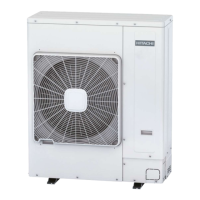4 Electrical wiring
108
SMGB0087 rev.0 - 12/2013
4.4 Electricalsettings
4.4.1 Outdoor and indoor unit electrical wiring
• Connect the electrical wires (indoor unit and the outdoor unit) as show in the gure.
• When installing the electrical wiring, follow local codes and regulations.
• The refrigerant piping and the control wiring are connected to the units in the same refrigerant cycle.
• Use twist pair wire (more than 0.75 mm
2
) for operation wiring between the outdoor unit and indoor unit, and operation
wiring between indoor unit and indoor unit.
• Use a 2-core wire for the operating line (do not use wire with more than 3 cores).
• Use shielded wires for intermediate wiring to protect the units from noise interference at lengths of less than 300 m.
The size must comply with local code.
• Open a hole near the connection hole of power source wiring when multiple outdoor units are connected from a single
power source line.
• The recommended breaker sizes are detailed in the Wire size section.
• In the case that a conduit tube for eld-wiring is not used, x rubber bushes with adhesive on the panel.
• All eld wiring and equipment must comply with local and international codes.
• H-LINK twist pair shielded cable must be grounded in the outdoor unit side.
C A U T I O N
Takecarewiththeconnectionoftheoperatingline.IncorrectconnectionmaycauseafailureofthePCB.
Powersourcefromtheoutdoorunittotheindoorunit Independentpowersourceofoutdoorunitandindoorunit
Number 0 System
Outdoor unit
Number 0 System
Outdoor unit
Operating Line
(Shielded Pair Cable)
DC5V (Non-Pole Transmission,
H-LINK System)
Remote control switch
(Twisted shielded pair cable)
Operating line
(Twisted shielded pair cable)
DC5V (Non-Pole
Transmission,
H-LINK System)
Indoor Unit
Indoor Unit
Terminal board
Circuit breaker
Earthleakage breaker
Field wiring
Field supplied
Optional accessory
Remote control switch
(Twisted shielded pair cable)
Indoor Unit
Indoor Unit

